The Jinn (also dJinn or genies, Arabic: الجن al-Jinn, singular الجني al-Jinnī) are spiritual creatures in Islam and Arabic folklore. They are mentioned in the Qur'an and other Islamic texts and inhabit an unseen world in dimensions beyond the visible universe of humans.
Throughout Arabian lore, there are different types of jinn; although the Qur’an mentions only three: Marid, ‘Ifrit, and Jinn. Other names include jann, ghoul, shaitans, hinn, nasnas, shiqq, si’lat, and a host of others. The names above vary depending on the region in the Middle Eastern country. Some of the best-known jinn are:
Ghoul
- Main article: Ghoul
The ghoul are shape-shifting, cannibalistic, and blood-drinking creatures that feed on the flesh of human beings,
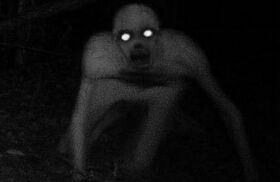
The Jinn Ghoul
especially travelers, children or corpses stolen out of graves. The oldest references to ghul in Arabian lore are found in The Book of 1001 Nights. There are several types of ghoul. The most feared is a female type (ghula) which has the ability to appear as a normal, mortal woman. According to lore, such a creature marries an unsuspecting man, who becomes her prey.
The ghoul are nocturnal creatures who inhabit graveyards, ruins and other lonely places. Sometimes they are described as dead humans who sleep for long periods in secret graves, then awake, rise and feast on both the living and the dead. Ghoul also personify the unknown terrors held by the desert.
In Persian lore the ghul has the legs of a donkey and the horns of a goat.
Hinn
- Main article: Hinn
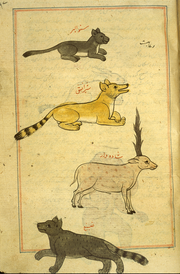
Hinn from Muḥammad al-Qazwīnī‘s “Marvels of Things Created and Miraculous Aspects of Things Existing”
The hinn are jinn, close to animals, and they especially like to appear as dogs.
In Miraculous Aspects of Things Existing (Arabic - كتاب عجائب المخلوقات وغرائب الموجودات), or The Book of Jinn, Zakarīyā’ ibn Muḥammad al-Qazwīnī claimed to have sighted these creatures in Arabia, Persia, and India. The book contains several pages dedicated to this particular Jinn.
‘Ifrit
- Main article: ‘Ifrit
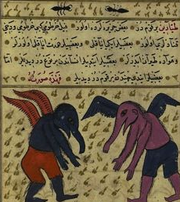
‘Ifrit from from Muḥammad al-Qazwīnī‘s “Marvels of Things Created and Miraculous Aspects of Things Existing”
The ‘ifrit (variation: afrit) is cited only once in the Qur’an, in reference to a djinni who fetched the throne of the Queen of Sheba at the command of King Solomon. In lore, it is evil and powerful, and difficult to control.
The Ifrits are in a class of infernal Jinn noted for their strength and cunning. An ifrit is an enormous winged creature of fire, either male or female, who lives underground and frequents ruins. Ifrits live in a society structured along ancient Arab tribal lines, complete with kings, tribes and clans. They generally marry one another, but they can also marry humans.
While ordinary weapons and forces have no power over them, they are susceptible to magic, which humans can use to kill them or to capture and enslave them. As with the jinn, an ifrit may be either a believer or an unbeliever, good or evil, but it is most often depicted as a wicked and ruthless being.
Jann
- Main article: Jann
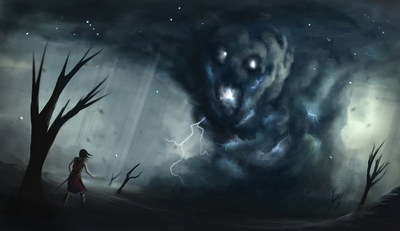
Artist’s rendering of Jann
Jann are shape-shifters who live in the desert, and take the forms of whirlwinds and white camels. They are open-minded about humans, and were among the first djinn encountered by people. They have the power to hide or reveal oases in the desert, depending on whether they like or dislike a party of travelers. They are the enemies of the ghoul.
Throughout history, the Jann have protected armies they deem as righteous, while impeding those they deem unworthy. The entire course of history is affected when they help a side. As a result, many events vital to Islamic history have been attributed to the Jann.
Marid
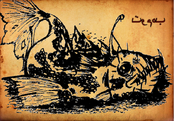
Traditional depiction of Bahamut, a non-humanoid Marid
- Main article: Marid
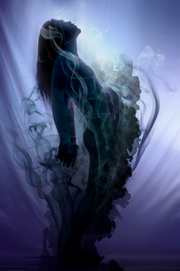
Artist’s rendering of a Marid Jinn
In Arabic folklore and common mythology, a Marid (Arabic: مارد mārid), is a large and powerful jinn. Marids are mentioned in pre-Islamic Arabian mythology and inside the One Thousand and One Nights alongside the Jinn in the story of The Fisherman and the Jinni. The term marid is still used in Arabic to refer to giants.
Mythology
Marids are often described as the most powerful type of jinn, having especially great powers. They are the most proud as well. Like every jinn, they have free will yet could be compelled to perform chores. According to folklore, they also have the ability to grant wishes to mortals, but that usually requires battle, imprisonment, rituals, or just a great deal of flattery. The Bahamut, the giant fish in the Qu'ran, is an example of a non-humanoid form of this particular Jinn.
Nasnas
- Main article: Nasnas
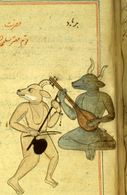
Nasnas from from Muḥammad al-Qazwīnī‘s “Marvels of Things Created and Miraculous Aspects of Things Existing”
The nasnas is another weak form of djinn, hybrids of human-
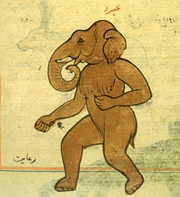
An Islamic "jinn" from Muḥammad al-Qazwīnī‘s “Marvels of Things Created and Miraculous Aspects of Things Existing.”
like and animal-like forms, and may account for some of our encounters with mysterious creatures. It is described in The Book of 1001 Nights as a half- human being, that is, it has half a head, half a body, one arm, one leg. It hops about on its single leg. The nasnas was said to be the offspring of a shiqq (see below) and a human being.
Also, in Somali folklore there is a creature called "xunguruuf" or "Hungruf" which resembles the "nasnās" as it has the same characteristics and features. It's believed it can kill a person by just touching them and the person would be flesh-less in mere seconds.
Palis
- Main article: Palis

Palis from Muḥammad al-Qazwīnī‘s “Marvels of Things Created and Miraculous Aspects of Things Existing”
The palis is a vampiric foot-licker that lives in the desert. It has low intelligence and can be easily outwitted, according to lore. It attacks sleeping people and drains their blood by licking the soles of their feet. It can be fooled by two people sleeping end to end with their soles of their feet together or under each other’s head.
Shaitan
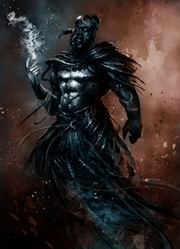
Artist’s rendering of a Shaitan
- Main article: demon
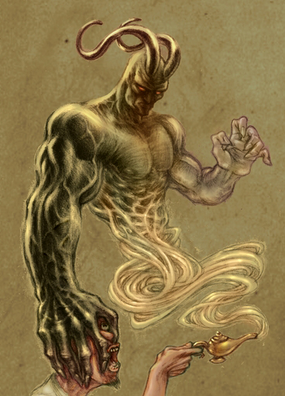
Artist’s rendering of Shaitan
(Arabic: شيطان, plural: شياطين shayāṭīn) is a malevolent creature in Islamic theology and mythology. Apart from its generic designation, used with the definite article Al-, Shaitan refers to the head of shayateen, known as Iblis.
Shayatin are generally hermaphrodite, unable to marriage or love, and reproduce by laying eggs. Unlike with other jinn, shayatin lack free-will; they can not choose between good and evil. The shaitan (shaytan) is a rebellious, malevolent djinni associated with demonic forces
Shiqq
- Main article: Shiqq
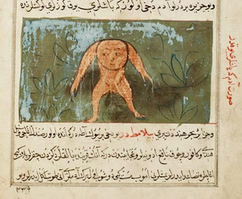
Kabandha as a Jinn from Muḥammad al-Qazwīnī‘s “Marvels of Things Created and Miraculous Aspects of Things Existing”
The shiqq is a lower form of djinn, a half creature,or literally only half-formed and thus monstrous in appearance. Muhammad al-Qazwīnī included Kabandha, the creature from the Southeast-Asian epic, Ramayana, as a Shiqq Jinn.
Si’lat

Si'lat, depicted from Muḥammad al-Qazwīnī‘s “Marvels of Things Created and Miraculous Aspects of Things Existing”
- Main article: Si’lat
The si’lat are expert shape-shifters and the smartest of the djinn. They can mimic human appearance with ease.
These creatures are also a part of person folklore.
